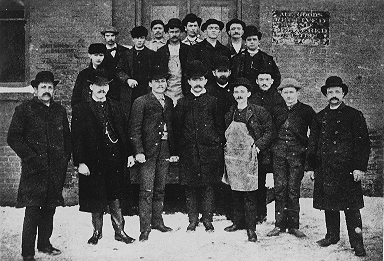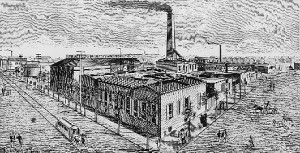History
Inspired by the possible money, John Hyatt began research into process. Hyatt developed a number of variations, but it was when he first thought of using collodion that he stumbled on part of the process for celluloid. Collodion is a solution of pyroxylin in ether and alcohol. One of its many uses was as a liquid bandage. When painted on the skin it becomes a flexible membrane. Hyatt worked as a printer and was used to using the solution to protect his hands.
Hyatt developed a system for casting collodion as a solid mass. Because it was clear, collodion could be successfully dyed to look like just about anything, but there were a number of problems. Besides its flammability, it was also too rigid. John Hyatt’s brother, Isaiah, had joined him in his research in 1869. Isaiah suggested they try adding camphor as others were experimenting with the resin from the camphora evergreen tree. Hyatt combined camphor and collodion and then applied heat. The result was a malleable mass that could be molded or cast.
The brothers received a patent on June 15, 1869, but continued to perfect their process. By 1870, they would have another patent and the product we think of as celluloid. It would be Isaiah Hyatt who would christen it “celluloid.” Also in 1870, the brothers opened the Albany Dental Plate Co. for the manufacture of celluloid denture blanks.

Celluloid Corporation executives and employees of the Converting Division in 1888. |
John Wyatt continued throughout his life to work on ways to perfect the manufacture of celluloid. Along the way he designed a number of other products including a machine for making slate blackboards, a process for solidifying hardwoods for bowling balls, a sewing machine cable of sewing 50 rows of stitches at once and more. In his lifetime he received 238 patents, 77 directly related to the manufacture of celluloid. He died in 1920.
There were a number of companies who manufactured celluloid for use in celluloid products. For an excellent history of celluloid and the companies that manufactured it, I highly recommend you read “Celluloid, Collector’s Reference and Value Guide” by Keith Lauer and Julie Robinson.
This website deals primarily with celluloid purses. However celluloid was used for a number of objects including jewelry, hair combs, hatpins, fans, vanity items, boxes, utensils, clocks, toys and much more. All of these items are highly collectible. So, if you enjoy celluloid purses, you may enjoy collecting other celluloid items.

